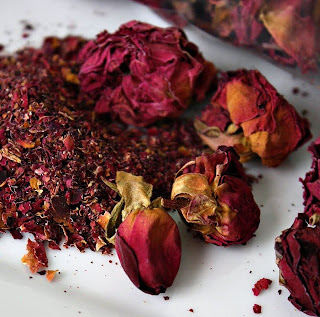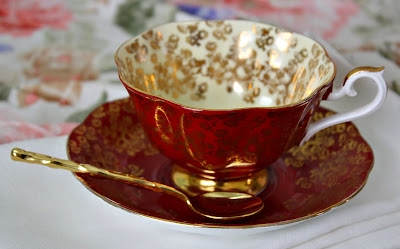My bakery merchandising class, which just ended last week, was interesting, fun, and a lot of work. One of my final projects involved baking, packaging, displaying, and promoting a selection of madeleines to be sold in the culinary school's retail bakery. We were allowed to make just about anything we wanted to, with our teacher's approval, and most of the items we created sold really well. There were neopolitan marshmallows, chocolate dipped meringue cookies, coconut macaroons, small decorated layer cakes, three-dimensional cookies that looked like the Eiffel tower, mocha brownie whoopie pies, petit fours, and mini-tarts. Along with all of that was the usual bakery fare--breads, pies, pastries, cookie bars, you name it. In light of all that was offered, I was astonished that the madeleines, which were packed in small boxes of six, sold out in a couple of hours. Because of their out of the ordinary flavor profiles I expected they might
not fly off the shelf, but luckily that wasn't the case.
I made three varieties--honey and lavender (made with dried culinary lavender and mild clover honey), orange blossom (made with orange blossom honey, orange flower water, and orange zest), and vanilla rose petal. After baking about 150 of the petite and tender cakes, I lightly glazed them and, once dry, carefully tucked them into boxes atop a frilly paper doily. The boxes were tied with narrow organdy ribbon (lavender, pale orange, or pink, depending on the flavor) and each was given a pretty label. They were on sale in conjunction with a festive Paris-themed dinner that was open to the public.

Have you ever made madeleines? They're simple to prepare but have their own idiosyncrasies and, contrary to what one might think, the assortment of recipes available to make them is pretty diverse. Some formulas make a big point of requiring that you chill the batter for hours, while others don't bother with this step at all. Some emphasize egg yolks, while others may require beaten egg whites. Some say that almond flour is
de rigeur, others don't even bring the topic up.

And then there's the controversial hump on the back of the madeleine: does its presence signal a better madeleine, or is the debate just a tempest in a teapot? I guess it's cute . . . as bumps, humps, and lumps on cakes or cookies go . . . but why all the hoopla? I cranked out many experimental batches of madeleines over the last several weeks and, as far as I can tell, that little hump--present or not--doesn't impact taste or texture one iota. In my humble opinion, you haven't failed if your madeleines don't emerge looking pregnant on one side, so don't worry. (Today's recipe is non-hump, just fyi.)
About this recipe . . .
Adapted from a plain madeleine recipe found in the
Cook's Illustrated website, this gives you a soft little cake. The use of dried rose petals, along with
rose water, was my idea; I am crazy about them. They both smell
so beautiful. I ordered these dried culinary roses from an
organic farm in Ohio, and they were remarkably inexpensive. To grind them finely, I pulsed them in a clean, small, coffee grinder that I often use as a spice grinder.
Have you ever baked with roses or rose water? No doubt about it, they don't show up in typical American baking very often, but they're absolutely worth a try. To the uninitiated, their perfume may seem startling. And it feels strange, at first, to put something that smells so floral into food (also true for orange flower water, or lavender), but it's the
purity of the scent that wins you over. They smell like the genuine essence of the flower itself, not soapy or synthetic. Use each sparingly, as a little of either ingredient goes an extremely long way.
Madeleines are good with a cup of tea, it's true. Bite into one, take a nice hot sip of tea, and let your thoughts drift like
Marcel Proust's. Perhaps you'll evoke an
"involuntary memory," something wonderful from your childhood, all
prompted by the mysterious taste of a flowery madeleine.
Vanilla Rose-Petal Madeleines
(For a printable version of this recipe, click here!)
Yield: 12 large madeleines
Carefully butter and flour a 12-cavity
madeleine pan.
(I use inexpensive pans from a company called Fox Run; they work just fine. I butter and flour more than just the cavities. To be entirely on the safe side I prep the entire top of the pan. Biggest potential problem with madeleines is getting them out of the pan. Take no chances!)
Preheat oven to 375 degrees.
Ingredients for batter:
2 large egg yolks, not cold
1 large whole egg, not cold
1/4 granulated sugar
3/4 tsp. rose water
3/4 tsp. vanilla extract
1/4 cup all-purpose flour
1/4 cup cake flour
1 pinch kosher salt
3/4 tsp. crushed or ground culinary rose petals (dried)
1/4 cup melted butter, not hot
Ingredients for glaze:
Approximately 1 cup confectioners' sugar, sifted
1 to 2 tsp. crushed rose petals
1 tsp. rose water, or adjust amount to taste
About 2 Tbsp. plain water (more or less depending on how thick you want your glaze)
To make the batter:
In a medium bowl, sift together the flours, salt, and ground rose petals. Set aside.
Using the whip attachment on your mixer, beat the egg yolks, whole egg, vanilla, and rose water on medium-high speed until frothy and fluffy, about three minutes. Slowly pour in the sugar, beating on medium-high speed for about five minutes or more, until you can see a ribbon of batter in the bowl when you stop the mixer and and lift the whip attachment. The batter should be very light and fluffy.
Take the bowl off the mixer. Gradually fold in the dry ingredients using a spatula. Fold very gently and carefully.
Then do the same with the melted butter.
Spoon the batter evenly into the madeleine pan, filling the cavities all the way. It's okay if the batter mounds over the top a bit. Don't bother smoothing the batter; you don't want to deflate it, and it will smooth out on its own in the oven.
Place the pan on the middle rack and bake for about 10 minutes, or until golden and the madeleines spring back when lightly pressed.
Spread out a clean dishcloth on your work surface. When the madeleines come out of the oven, turn them out right onto the dishcloth. You need to get them out of the pans while they're still very hot. Do
not let them cool in the pans.
While they're still warm, glaze them. Make the glaze by whisking the sifted confectioners' sugar with the crushed rose petals. Stir in rose water and plain water and keep stirring until the glaze is lump free. I think it's best to make the glaze pretty thin. The madeleines are delicate when warm, so they're easily broken. The heavier the glaze, the more likely they'll be damaged. I glaze mine by holding some glaze in a large spoon over a small bowl of glaze, and I dip just the shell-shaped top in the glaze.
Let the glazed madeleines dry on the dishcloth. Store them tightly covered after they're dry and fully cooled. They're best when very fresh, but are pretty good for about the first two days.
(If you'd like to comment on this post, or to read existing comments, please click on the purple COMMENTS below!)

